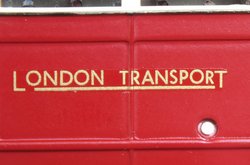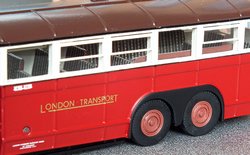The paint used on the model has satin finish rather than the more usual full gloss found on most models. Whether you like this will be down to personal taste, but on the whole it's probably more in keeping with the scale and typical condition of paint finish on an in service vehicle.
The paint application is very even & has been thinly applied meaning that none of the finer casting details is lost beneath it.

All the decals are reproduced using transfers and on the whole these look to be accurate reproductions, the only slight issue is that these have a shiny backing material which tends to stand out against the satin paint finish under the certain lighting conditions.

The joins between the different paint colours are clean with no sign whatsoever of any bleed. Black lining has been applied above and below the passenger windows and again this is faultless.
This second Scooter model appears to have a few extra features over the earlier Bromley Garage version. Hand rails have now been added to either side of the entrance and across the front bulkhead. There's also a ceiling mounted rail in the front section of the saloon. These are all made of a very fine grade silver wire and look in keeping with the scale.
The head & side lights now also have clear plastic lenses which is a big improvement over the silver paint used on the first issue.



